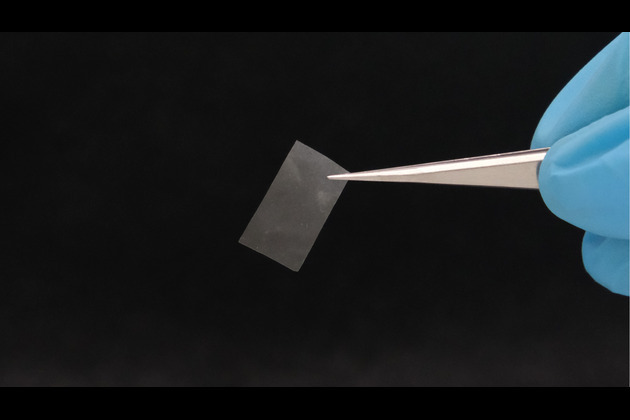Scientists in Zurich develop living material with unique properties
Anabelle Colaco
16 Jun 2025, 16:20 GMT+10

- In a breakthrough that could reshape the future of sustainable materials, scientists at Empa’s Cellulose and Wood Materials laboratory in Zurich have developed an extraordinary biodegradable material—made from fungi
- Engineered from the living structure of fungal mycelium and its natural matrix, this new material is tear-resistant, multifunctional, fully biodegradable—and even edible
- What makes this innovation remarkable is not just its eco-friendly profile but also its performance
ZURICH, Switzerland: In a breakthrough that could reshape the future of sustainable materials, scientists at Empa's Cellulose and Wood Materials laboratory in Zurich have developed an extraordinary biodegradable material—made from fungi.
Engineered from the living structure of fungal mycelium and its natural matrix, this new material is tear-resistant, multifunctional, fully biodegradable—and even edible.
What makes this innovation remarkable is not just its eco-friendly profile but also its performance. Traditionally, biodegradable materials made from natural polymers like cellulose, lignin, or chitin fall short in strength or flexibility. To improve them, chemical treatments are often used, sacrificing sustainability. Empa's living material elegantly sidesteps that trade-off.
The team turned to the split-gill mushroom, a common edible fungus that grows on decaying wood. Its underground root-like network, known as mycelium, is already being studied for its potential in material science. But unlike other processes that strip the mycelium of its natural elements, Empa researchers chose to use it whole—preserving not just the structural fibers (called hyphae) but also the extracellular matrix the fungus produces as it grows.
"The fungus uses this matrix to give itself structure and special properties," says Empa researcher Ashutosh Sinha. "Why shouldn't we do the same?"
That matrix contains two key substances: schizophyllan, a nanofiber-forming polysaccharide, and hydrophobin, a soap-like protein. Together, these give the material its strength and adaptability. Hydrophobins are especially good at bridging water and oil—making them ideal for creating stable emulsions, such as those found in mayonnaise or salad dressing.
In fact, Empa researchers have already used their living material to create both a plastic-like film and a biologically stable emulsion, which may be the first of its kind to grow more stable over time. "This is probably the only emulsion that gets stronger the longer it sits," Sinha notes.
Even better, the mushroom-derived material is entirely non-toxic, edible, and biocompatible. The split-gill mushroom is already widely eaten, which opens doors to safe applications in cosmetics, food, and packaging.
In another experiment, the team produced thin, strong films from the mycelium by aligning the fibers to maximize tensile strength—combining the structure of traditional fiber processing with the unique advantages of living materials. "Our mycelium is essentially a living fiber composite," Sinha explains.
By fine-tuning the conditions under which the fungus grows, the researchers can control the material's properties—possibly even experimenting with other fungal species to produce different functional compounds. However, working with living materials isn't without its challenges.
"Biodegradable materials always react to their environment," warns Nyström. "We want to find applications where this interaction is not a hindrance but maybe even an advantage."
The mycelium's biodegradability is just one aspect—it's also a biodegrader itself, capable of decomposing wood and other plant materials.
Sinha suggests, "Instead of compostable plastic bags, it could be used to make bags that compost the organic waste themselves."
Since the fungus can also degrade plant matter, it could double as both a container and composter.
Looking ahead, the team also sees potential in sustainable electronics. The fungal material reversibly responds to humidity, making it a candidate for biodegradable moisture sensors.
It turns out that nature has already built a high-performance system. Empa's team is simply learning to work with it.
In another initiative, Nyström's team is integrating this living material with two other research projects from the Cellulose and Wood Materials laboratory: the fungal biobattery and the paper battery.
"We want to produce a compact, biodegradable battery whose electrodes consist of a living 'fungal paper,'" reveals Sinha.
 Share
Share
 Tweet
Tweet
 Share
Share
 Flip
Flip
 Email
Email
Watch latest videos
Subscribe and Follow
Get a daily dose of South America Times news through our daily email, its complimentary and keeps you fully up to date with world and business news as well.
News RELEASES
Publish news of your business, community or sports group, personnel appointments, major event and more by submitting a news release to South America Times.
More InformationInternational
SectionHistoric ISS mission launches with crew from 4 different nations
CAPE CANAVERAL, Florida: In a landmark flight for three nations and a veteran U.S. spacefarer, a four-member astronaut crew launched...
U.S. government sues Maryland court over pause in migrant deportations
WASHINGTON, D.C.: In a striking escalation of tensions between the executive and judicial branches, the Trump administration has filed...
Thailand-Cambodia tensions rise as border rules tighten
BANGKOK, Thailand: This week, Thailand implemented land border restrictions, including a ban on tourists traveling to Cambodia, as...
Alliance eyes major military buildup to counter Russia
THE HAGUE, Netherlands: NATO is pressing ahead with a sweeping new defense spending target, calling on all 32 member nations to commit...
Mamdani leads NYC mayoral race in stunning upset over Cuomo
NEW YORK, U.S.: A political newcomer is on the verge of reshaping New York City politics. Zohran Mamdani, a 33-year-old state assemblyman...
Millions endure dangerous US temperatures, heat alert issued
MADISON, Wisconsin: Tens of millions of residents across the Midwest and East Coast faced dangerously high temperatures over the weekend...
Latin America
SectionBrazil’s ex-president accused of leading illegal spy operation
BRASILIA, Brazil: Former Brazilian President Jair Bolsonaro is accused of playing a key role in an illegal surveillance operation orchestrated...
China Sports Weekly (6.22-6.28)
BEIJING, June 28 (Xinhua) -- Here are the latest Chinese sports headlines from the past week: 1. China's Wang Xinyu finishes runner-up...
(SP)CANADA-TORONTO-FOOTBALL-INTERNATIONAL WOMEN'S FRIENDLY MATCH-CANADA VS COSTA RICA
(250628) -- TORONTO, June 28, 2025 (Xinhua) -- Marie-Yasmine Alidou (C) of Canada vies with Fabiola Villalobos (R) of Costa Rica during...
Australia's Steve Smith takes step closer to return, had "few hits" in New York, confirms skipper Cummins
Bridgetown [Barbados], June 28 (ANI): Australia's batting mainstay Steve Smith is set to rejoin the squad in Barbados and had a crack...
Cummins picks Australia's "special" player after wrapping up "great" Test against WI with victory
Bridgetown [Barbados], June 28 (ANI): Australia captain Pat Cummins was all in praise of 'special' Josh Hazlewood, who ripped through...
PM Modi to embark on five nation-visit from July 2, attend BRICS Summit in Brazil
New Delhi [India], June 27 (ANI): Prime Minister Narendra Modi will embark on a five-nation visit from July 2, during which he will...













